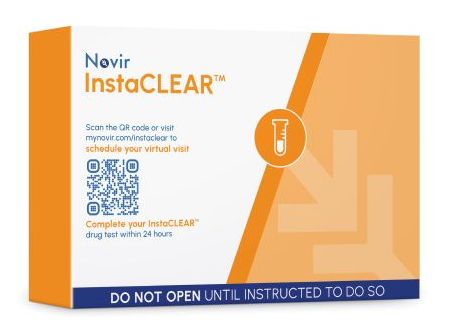Drug of Abuse: A Primer
You can test for all of these and more at InOut Labs.
Amphetamine/Methamphetamine
Central nervous system (CNS) stimulants increase energy, alertness, and euphoria at high doses. However, they can also cause anxiety, paranoia, psychotic behavior, and irregular heartbeats. The body removes methamphetamine through urine, partly as amphetamine and partly unchanged. Common examples include Adderall, Benzedrine, Biphetamine, Dexedrine, Durophet, and Obetrol.
Barbiturates
CNS depressants slow brain activity and cause effects similar to alcohol intoxication. As a result, users may experience slurred speech, poor coordination, and bad judgment. Over time, they quickly build a tolerance and often become physically and mentally dependent. People usually take these drugs by mouth or through injections. The body removes them through urine as both the original drug and its byproducts. Common examples include Phenobarbital, Nembutal Sodium, Seconal Sodium, Antrocol Elixor, Pentobarbital Sodium, Secobarbital Sodium, Bellergal-S, Donnatal, Kenesed, Luminal, Mudrane GC, Quadrinal, Rexatal, and Solfoton.
Benzodiazepines
CNS depressants, often used to treat anxiety and insomnia, affect the brain depending on the dose. In high amounts, they work as sleep aids; in moderate amounts, they ease anxiety; and in low amounts, they calm the body. As a result, users may feel sleepy or confused. People usually take them by mouth or through injections. The body gets rid of both the drug and its byproducts through urine. Common examples include Valium, Rivotril, Triazolam (Halcion), Flurazepam, Lorazepam (Ativan), Dormonocet, and Xanax.
Buprenorphine (aka Suboxone)
Buprenorphine, also known as Suboxone, works as both a pain reliever and an opioid. It is 25 to 40 times stronger than morphine when used for pain. However, taking too much can lead to confusion, dizziness, small pupils, hallucinations, low blood pressure, trouble breathing, seizures, or even coma. After an intramuscular dose, the body removes about 95% of the drug within 24 hours, with around 27% passing through urine.
Cocaine
Cocaine acts as both a central nervous system stimulant and a local anesthetic. It often causes feelings of euphoria, confidence, and a burst of energy. In addition, it raises heart rate, widens pupils, and may lead to fever, tremors, and sweating. The body breaks it down into metabolites, which typically show up in urine for 24 to 60 hours after use.
Marijuana (THC)
The principle component in marijuana. Ingested or smoked. CNS effects are altered mood and sensory perceptions, loss of coordination, impaired short term memory, anxiety, paranoia, depression, confusion, hallucinations and increased heart rate. It is metabolized by the liver.
MDMA/Ecstasy/Molly
Both a stimulant and a hallucinogen. Adverse effects of MDMA use include jaw clenching, teeth grinding, dilated pupils, perspiring, anxiety, blurred vision, vomiting, and increased blood pressure and heart rate. Overdose may cause heart failure or extreme heat stroke. Taken orally and excreted in urine as parent compound as well as metabolites.
Methadone
Synthetic analgesic drug used for the treatment of narcotic addiction. Effects are analgesia, sedation, and respiratory depression. Overdose may cause coma or even death. Taken orally or intravenously, it is metabolized in the liver.
Opiates
Heroin, morphine, and codeine, are CNS depressants. It produces euphoria and release from anxiety. Dependence leads to depressed coordination, disrupted decision making, decreased respiration, hypothermia and coma. Heroin is quickly metabolized to morphine, morphine glucuronide and 6-acetylmorphine. The presence of morphine (or the metabolite, morphine glucuronide) in the urine may indicate heroin, morphine, and/or codeine use.
Oxycodone, Oxymorphone, Hydorcodone, Hydromorphone
Semi-synthetic opioid similar to codeine. It produces euphoria, analgesic and sedative effects, and has a dependence similar to morphine. It’s mostly taken orally. Detection in urine is similar to that of other opioids and is included in Expanded Opiates panels. Some common names for the new semi-synthetic opioids include OxyContin®, Percodan®, Percocet®, Vicodin®, Lortab®, Norco®, Dilaudid®, and Exalgo®.
Phencyclidine (PCP)
Also known as “angel dust” and “crystal cyclone.” Originally used as an anesthetic agent and a veterinary tranquilizer. Taken orally by nasal ingestion, smoking, or intravenously. It produces hallucinations, lethargy, disorientation, loss of coordination, trance-like states, a sense of euphoria and visual distortions. Found in urine in moderate amounts.
Propoxyphene
A mild narcotic analgesic. Taken orally, also found in combination with aspirin or acetaminophen. Overdose: stupor, coma, convulsions, respiratory depression, cardiac arrhythmias, hypotension, pulmonary edema and circulatory collapse.

